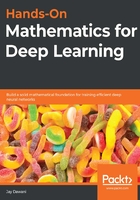
Variance
We define the variance of X as follows:

The standard deviation of X is the square root of the variance:

We can think of this as how spread out or close values are from the expected (mean) value. If they are highly dispersed, then they have a high variance, but if they are grouped together, then they have a low variance.
Here are some properties for variance that are important to remember:
 .
.- If
 , then
, then  .
.  .
. .
. , given that all the Xi values are independent.
, given that all the Xi values are independent.
Let's suppose that we now have  discrete random variables. Then, they are independent if we take the following:
discrete random variables. Then, they are independent if we take the following:

Now, let our n random variables be independent and identically distributed (iid). We now have the following:

This concept is very important, especially in statistics. It implies that if we want to reduce the variance in the results of our experiment, then we can repeat the experiment a number of times and the sample average will have a small variance.
For example, let's imagine two pieces of rope that have unknown lengths—a and b, respectively. Because the objects are ropes—and, therefore, are non-rigid—we can measure the lengths of the ropes, but our measurements may not be accurate. Let A be the measured value of rope a and B be the measured value of rope b so that we have the following:

We can increase the accuracy of our measurements by measuring X = A + B and Y = A – B. Now, we can estimate a and b using the following:

Now,  and
and  , which are both unbiased. Additionally, we can see that the variance has decreased in our measurement using the following:
, which are both unbiased. Additionally, we can see that the variance has decreased in our measurement using the following:

From this, we can clearly see that measuring the ropes together instead of separately has improved our accuracy significantly.